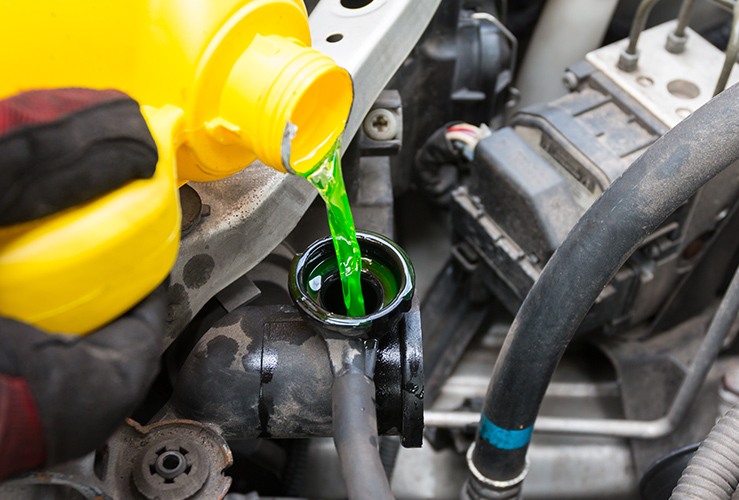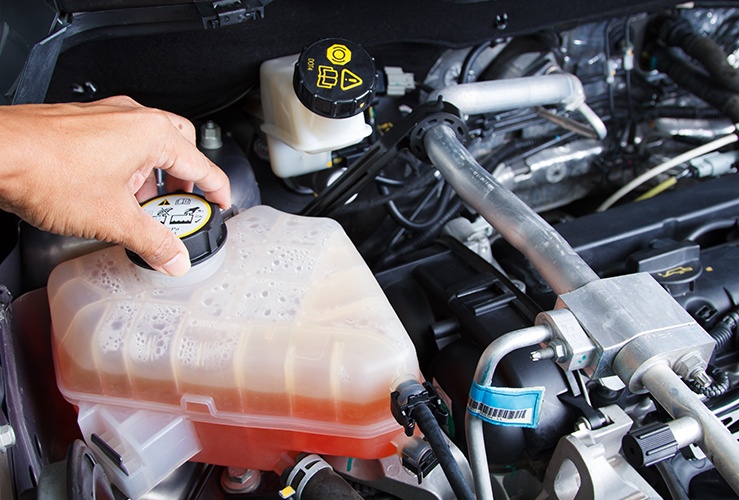Armed with a little mechanical knowledge, it's possible to replace your car’s engine coolant by yourself - and save money in the process. Learn how to complete this relatively straightforward task, with our guide.
Ensuring your vehicle's engine has sufficient coolant is critical to avoid both overheating and freezing. Staying on top of this important area of vehicle maintenance will help prevent breakdowns, as well as engine damage - which can be costly to repair.
Here we explain how to drain, flush and top-up your engine’s coolant, and when to do it. Unlike some maintenance tasks, it’s possible to accomplish this without the help of a mechanic. However, most car owners do prefer to use the services of a mechanic.
Why is coolant so important?
Coolant - also known as antifreeze - helps to regulate the temperature of your engine, ensuring it gets neither too hot nor too cold.
Maintaining optimum levels of fresh coolant also helps prevent rust and corrosion, since coolant contains corrosion inhibitors.
Getting your water-to-antifreeze ratio right
Coolant comprises distilled water and antifreeze. The ratio of these two fluids needs to be correct, or it won’t work as required. Refer to your owner's manual for the right water-antifreeze ratio.
It's important to know that the ratio will vary between different models. That said, most mixing ratios are between 60:40 and 50:50.

Why do I need to use distilled water?
Don't be tempted to use regular tap water when mixing your coolant. Tap water contains organic contaminants and minerals which can build up in your car's coolant system and lead to corrosion.
If you don’t want to mix your own coolant, you can buy premixed products from an autocentre, or online. However, as mentioned you need to ensure that it has the right water-antifreeze ratio.
When should I replace my coolant?
Refer to your owners' manual to find out how often you should replace your engine coolant. Generally speaking, it should be done every 30,000 to 50,000 miles.
You can also carry out a visual inspection of the coolant reservoir. If the level is below the minimum line, you'll need to top up your coolant.
Your coolant may need to be topped up sooner than stated in your owner's manual. There are several possible reasons for this, including:
- Frequent stop-start driving in urban areas
- Towing heavy loads
- Driving in extreme temperatures for long periods
- Coolant leaks
If unsure, you can ask your local mechanic to top up your coolant levels.
Is it cheaper to replace the coolant myself?
Yes, replacing your own coolant is considerably cheaper than using your local mechanic to do the job. Buying the coolant and distilled water can cost as little as £15 to £20, while your local garage may charge in excess of £100. However, how much your garage charges will depend on the make and model of your car, and your location (a garage in a big city may charge more than a rural one, for example).

Watch online videos specific to your model
YouTube is a useful resource when it comes to replacing coolant on specific makes and models. These videos can be especially helpful as regards pinpointing the coolant release valve/hose, and learning about the flushing process. However, refer to your owner’s manual in the first instance, and if you’re at all unsure, take your car to a garage instead.
How to replace your engine coolant
As mentioned, while a mechanic can top up your coolant levels for you, it's possible to complete the task yourself. However, note that locating the coolant drain pipe or tap can be tricky with some models, and you may need a jack and jack stand.
Here we explain the different steps in the process.
What you will (or may) need:
- Car jack
- Jack stand axle
- Antifreeze
- Distilled water
- Screwdrivers
- Drain pan to collect old coolant
- Old clothes
- Gloves
- Safety glasses
- Old rags/towels
Prepare your vehicle
Before replacing your coolant, ensure your engine has had time to cool down. To be on the safe side, let it cool down overnight. Attempting any maintenance tasks on a hot engine could result in getting burnt.
Before proceeding, ensure your vehicle is parked on level ground with the handbrake engaged, then open the bonnet, and find the radiator and coolant reservoir.
It's a good idea to wear old clothes for this job, since you're likely to get dirty.
In order to access the coolant valve/hose on the underside of the vehicle, you may need to jack the car up, and use a jack axle stand to keep the vehicle raised.
Drain the old coolant
Place a pan beneath the radiator to catch the old coolant.
You may need to remove the under tray to access the drain valve/hose.
On most vehicles there's a drain pipe or tap on the back side of the radiator. Twist this open and let the old coolant drain out.
On other models, locating the drain pipe/tap can be more difficult. With some vehicles, you may need to pull the lower hose off the radiator to let it drain out. This can involve some twisting and tugging.
The hose is likely to be fixed in place with a clamp or clip. These can be tricky to get off. remember that you'll need to replace these clamps or clips after you've drained the coolant.
It can take some time for all the old coolant to drain out.
Be sure to dispose of the old coolant responsibly, since it is toxic to humans, animals and plant life. Note that pets can be attracted to the coolant’s sweet smell.
Search online for your nearest coolant recycling centre. Your local council may provide suitable facilities. Gov.uk has a useful page for finding a local coolant recycling point.
Flush the system
Once the old coolant has drained out, set about flushing the system with distilled water. This should remove any remaining contaminants or residue. Specialised coolant flush kits are available for this task. Simply replacing the coolant without flushing could mean contaminants remain present in your system, potentially reducing its lifespan.

Add fresh coolant
Having flushed the system, close the drain valve/hose and add new coolant to the coolant reservoir (ensuring it has the right ratio of distilled water and coolant). Ensure the coolant level is between the ‘min’ and ‘max’ lines on the reservoir. The average car needs about 5 litres of coolant, although this can vary between models.
Bleed out any air bubbles
With the radiator cap off, start the engine and let it run for a few minutes. This will remove any air bubbles in the coolant system.
Inspect the system for leaks
Check the connections, hoses, and radiator for any leaks. Ensure the clamps are tight, and replace any damaged/faulty components.
Should I employ a mechanic to replace coolant instead?
Replacing your own coolant can save time and money, and could be a good option for those with a modest amount of mechanical knowledge and experience, and basic tools and equipment. However, the task can be complicated if you can’t find the drain valve, and will almost certainly involve your clothes getting dirty. You’ll also need to be reasonably fit and able, since you’ll be accessing the underside of your car.
For those with little technical knowledge and experience, or who don’t have time to complete the task, it may be easier to simply take your car to your local garage. Additionally, mechanics have access to surface-mounted or scissor lifts, which make it much easier to access the coolant drain valve/hoses.




